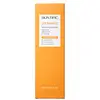What's inside
What's inside
 Key Ingredients
Key Ingredients

 Benefits
Benefits

 Concerns
Concerns

 Ingredients Side-by-side
Ingredients Side-by-side

Water
Skin ConditioningMyristic Acid
CleansingPalmitic Acid
EmollientGlycerin
HumectantDiglycerin
HumectantLauric Acid
CleansingPotassium Hydroxide
BufferingStearic Acid
CleansingPEG-6
HumectantPPG-24-Glycereth-24
EmulsifyingNiacinamide
SmoothingPPG-10 Sorbitol
PEG/PPG-25/30 Copolymer
SolventPropylene Glycol
HumectantAroma
Potassium Cocoyl Glycinate
Maltooligosyl Glucoside
Skin ConditioningAlpha-Arbutin
AntioxidantHydroxystearic Acid
CleansingSaccharomyces Ferment Filtrate
HumectantPolyquaternium-7
Phenoxyethanol
PreservativePEG-17 Dimethicone
Skin ConditioningOctyldodecanol
EmollientCeramide NP
Skin ConditioningPolyquaternium-6
Hydrogenated Lecithin
EmulsifyingButylene Glycol
HumectantEthylhexylglycerin
Skin ConditioningAscorbic Acid
AntioxidantBromelain
Skin ConditioningHydrogenated Starch Hydrolysate
HumectantSodium PCA
HumectantCastoryl Maleate
Skin ConditioningHyaluronic Acid
HumectantGlucose
HumectantGlyceryl Hydroxystearate
Emollient1,2-Hexanediol
Skin ConditioningPolyquaternium-43
Tremella Fuciformis Extract
HumectantPolyglyceryl-10 Stearate
Skin ConditioningSodium Benzoate
MaskingLactobacillus Ferment Lysate
Skin ConditioningPhytosphingosine
Skin ConditioningCholesterol
EmollientCitric Acid
BufferingCaprylyl Glycol
EmollientPhospholipids
Skin ConditioningBHT
AntioxidantSodium Polynaphthalenesulfonate
Emulsion StabilisingCeramide Ns
Skin ConditioningCeramide As
Skin ConditioningCeramide AP
Skin ConditioningCI 11680
Cosmetic ColorantCI 12490
Cosmetic ColorantSodium Sulfate
Sodium Laureth Sulfate
CleansingCentella Asiatica Extract
CleansingPapain
Skin ConditioningHydrolyzed Pearl
Skin ConditioningCarbomer
Emulsion StabilisingCeramide EOP
Skin ConditioningHydroxyacetophenone
AntioxidantAlgin
MaskingWater, Myristic Acid, Palmitic Acid, Glycerin, Diglycerin, Lauric Acid, Potassium Hydroxide, Stearic Acid, PEG-6, PPG-24-Glycereth-24, Niacinamide, PPG-10 Sorbitol, PEG/PPG-25/30 Copolymer, Propylene Glycol, Aroma, Potassium Cocoyl Glycinate, Maltooligosyl Glucoside, Alpha-Arbutin, Hydroxystearic Acid, Saccharomyces Ferment Filtrate, Polyquaternium-7, Phenoxyethanol, PEG-17 Dimethicone, Octyldodecanol, Ceramide NP, Polyquaternium-6, Hydrogenated Lecithin, Butylene Glycol, Ethylhexylglycerin, Ascorbic Acid, Bromelain, Hydrogenated Starch Hydrolysate, Sodium PCA, Castoryl Maleate, Hyaluronic Acid, Glucose, Glyceryl Hydroxystearate, 1,2-Hexanediol, Polyquaternium-43, Tremella Fuciformis Extract, Polyglyceryl-10 Stearate, Sodium Benzoate, Lactobacillus Ferment Lysate, Phytosphingosine, Cholesterol, Citric Acid, Caprylyl Glycol, Phospholipids, BHT, Sodium Polynaphthalenesulfonate, Ceramide Ns, Ceramide As, Ceramide AP, CI 11680, CI 12490, Sodium Sulfate, Sodium Laureth Sulfate, Centella Asiatica Extract, Papain, Hydrolyzed Pearl, Carbomer, Ceramide EOP, Hydroxyacetophenone, Algin
Water
Skin ConditioningMyristic Acid
CleansingStearic Acid
CleansingGlycerin
HumectantPotassium Hydroxide
BufferingLauramine Oxide
CleansingCetyl Alcohol
EmollientCamellia Sinensis Leaf Extract
AntimicrobialSalicylic Acid
MaskingButylene Glycol
HumectantHydroxyethylcellulose
Emulsion StabilisingGlyceryl Stearate Se
EmulsifyingGlycol Stearate
EmollientTetrasodium EDTA
Parfum
MaskingImidazolidinyl Urea
PreservativeIngredients Explained
These ingredients are found in both products.
Ingredients higher up in an ingredient list are typically present in a larger amount.
Butylene Glycol (or BG) is used within cosmetic products for a few different reasons:
Overall, Butylene Glycol is a safe and well-rounded ingredient that works well with other ingredients.
Though this ingredient works well with most skin types, some people with sensitive skin may experience a reaction such as allergic rashes, closed comedones, or itchiness.
Learn more about Butylene GlycolGlycerin is already naturally found in your skin. It helps moisturize and protect your skin.
A study from 2016 found glycerin to be more effective as a humectant than AHAs and hyaluronic acid.
As a humectant, it helps the skin stay hydrated by pulling moisture to your skin. The low molecular weight of glycerin allows it to pull moisture into the deeper layers of your skin.
Hydrated skin improves your skin barrier; Your skin barrier helps protect against irritants and bacteria.
Glycerin has also been found to have antimicrobial and antiviral properties. Due to these properties, glycerin is often used in wound and burn treatments.
In cosmetics, glycerin is usually derived from plants such as soybean or palm. However, it can also be sourced from animals, such as tallow or animal fat.
This ingredient is organic, colorless, odorless, and non-toxic.
Glycerin is the name for this ingredient in American English. British English uses Glycerol/Glycerine.
Learn more about GlycerinMyristic Acid is a saturated fatty acid. It is naturally found in milk fat. Other sources include palm oil, coconut oil, and butter fat.
Myristic Acid is an emulsifer and cleanser. As an emulsifer, it stabilizes a product by preventing ingredients from separating. Myristic Acid helps clean your skin by acting as a surfactant. It tends to gather oil and dirt on your skin to be easily rinsed away.
One study from 2021 found Myristic Acid to have anti-inflammatory properties.
Learn more about Myristic AcidPotassium hydroxide is commonly known as caustic potash. It is used to fix the pH of a product or as a cleaning agent in soap. In cleansers, it is used for the saponification of oils.
Sapnification is the process of creating fatty acid metal salts from triglycerides and a strong base. During this process, Potassium Hydroxide is used up and is not present in the final product.
Using high concentrations of Potassium Hydroxide have shown to irritate the skin.
Learn more about Potassium HydroxideStearic Acid is a fatty acid. It is an emollient, emulsifier, and texture enhancer.
As an emollient, stearic acid helps soften skin. It aids the skin's protective barrier by preventing water loss. It also provides a gentle cleansing effect without stripping away natural oils.
Stearic acid may also be used to enhance the texture of products. It can add volume and stabilize ingredients such as water and oil. This can help water and oil ingredients from separating.
Sources of stearic acid include animal or vegetable fats/oils such as coconut or shea. It can be naturally found in butter, cocoa butter, shea butter, vegetable fats, and animal tallow.
This ingredient may not be Malassezia folliculitis, or fungal-acne safe.
Learn more about Stearic AcidWater. It's the most common cosmetic ingredient of all. You'll usually see it at the top of ingredient lists, meaning that it makes up the largest part of the product.
So why is it so popular? Water most often acts as a solvent - this means that it helps dissolve other ingredients into the formulation.
You'll also recognize water as that liquid we all need to stay alive. If you see this, drink a glass of water. Stay hydrated!
Learn more about Water